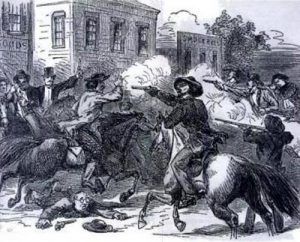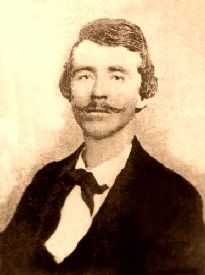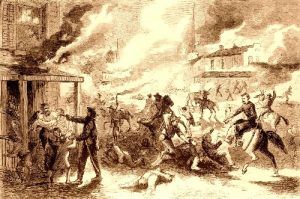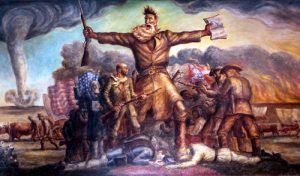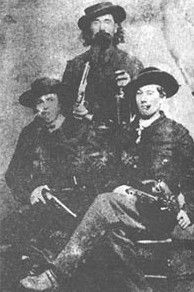
Missouri Border Ruffians, also called Bushwhackers.
Before and during the Civil War, “bushwhacking” was a form of guerrilla warfare prevalent along the Kansas–Missouri border. Though the term “bushwhacker” applied to Union and Confederate forces, it was a much-feared term for pro-slavery guerilla fighters in Kansas. Alternatively, guerrilla fighters in Kansas, including the “Jayhawkers” and the “Red Legs,” also committed many depredations,
The term “bushwhacker” means “One accustomed to beat about or travel through bushes or one who lives in or frequents the woods.” The Federal troops specifically applied it in the Civil War to irregular troops of the Confederate states engaged in guerrilla warfare. Although this definition made the words “bushwhacker” and “guerrilla” synonymous, there was a distinction between them — with the true bushwhacker generally fighting undercover and the guerilla frequently having sufficient courage to come out into the open.
Bushwhackers were not generally part of either side’s military command and control. With raids starting years before the Civil War began, as Kansas fought to become a Free-State, it conducted a few well-organized raids. Still, most attacks involved ambushes of individuals or families in rural areas.
Years before the Civil War began, several battles were fought between Free-State advocates and pro-slavery men during the days of Bleeding Kansas, which often included guerilla fighters. These battles included the Wakarusa War in December 1855. In 1856, several skirmishes occurred, including the Sacking of Lawrence, the Pottawatomie Massacre, the Battle of Black Jack, the Battle of Franklin, the Battle of Fort Saunders, the Battle of Fort Titus, the Battle of Osawatomie, and the Battle of Hickory Point. The final major atrocity committed by Missouri bushwhackers before the outbreak of the war was the Marais des Cygnes Massacre in May 1858.
During the early years of the Civil War, the borderline between the Northern and the Confederate states was infested by guerrillas. In a few instances, these irregular soldiers favored the Union cause. Still, they were secessionists in many cases, and sometimes they cared more for plunder than they did for principle. William Quantrill was the most well-known guerrilla leader in western Missouri and Kansas. Other men included Upton Hays, John Thrailkill, Coon Thornton, William “Bloody Bill” Anderson, Frank James, Cole Younger, Bill Todd, John Jarrette, George Shepherd, Dick Yeager, and numerous others. Several of these men were only privates, but their daring and blood-thirsty deeds won notoriety that has carried their names into history.
Upton Hays commanded the “Partisan Rangers” in western Missouri until William Quantrill succeeded him in 1862. Guerrilla gangs made several raids into Kansas over the years. In September 1861, the town of Humboldt was raided by “Colonel” John Matthews, who sacked nearly every house and store in the settlement. In October, Mathews was part of yet another raid on the town for revenge for his father’s death after the first raid. At about the same time, the small town of Gardner in Johnson County was also plundered. On March 7, 1862, Quantrill raided Aubry, a small town in the southeast corner of Johnson County, where he killed three men and destroyed considerable property. In June, Bill Anderson made a foray as far west as Council Grove, killing two men and burning at least one house. On September 6th and 7th, Quantrill visited Olathe, where he destroyed and carried off a lot of property. In October, he descended upon Shawnee in Johnson County, where seven citizens were killed. Just before visiting the town, he attacked the camp of a Santa Fe Trail wagon train and killed 15 members of the escort. Humboldt was again visited in 1862 by “Colonel” Talbot, who burned several buildings, plundered the town, and killed four or five citizens who tried to defend their homes.
On August 15, 1862, William Quantrill was commissioned as a captain in the Confederate Army and was placed in command of a company of 150 men. William C. Haller was made first lieutenant; George Todd, second lieutenant; and William H. Gregg, third lieutenant. Whatever the acts of these men had been before that time, after that date, they were supposedly acting under the authority of the Confederate Army.
In May 1863, John Jarrette, Cole Younger, and other minor guerrilla leaders united their gangs with Quantrill’s command. In May 1863, Dick Yeager left Missouri on the Santa Fe Trail, crossed over into Kansas, and on May 4, encamped near Council Grove. That night he raided the little village of Diamond Springs, where he killed one man and wounded a woman.
On the return trip, he stopped at Rock Springs, a stage station near the line of Osage and Douglas Counties, where he met and killed George N. Sabin, a soldier of Company K, Eleventh Kansas, who had been at his home in Pottawatomie County on leave and was on his way to rejoin his regiment.
Seven miles farther down the road, Yeager’s men shot and seriously wounded David Hubbard before passing through Baldwin City and Black Jack, where they robbed the stage, and then returned to Missouri via Gardner, Kansas.
The next event was the worst atrocity committed by the Missouri guerillas. On August 21, 1863, William Quantrill led some 300 men in the Lawrence Massacre, which targeted Lawrence due to its long support of abolition and reputation as a center for the Jayhawkers. By the time Quantrill’s men rode out of town, more than a quarter of the buildings had been burned to the ground, the banks and stores looted, and some 185-200 men were dead.
Just after the raid on Lawrence, Quantrill passed through the old town of Brooklyn, where he did some damage, and on October 6, 1863, his men ruthlessly massacred some Federal troops in the Baxter Springs Massacre. Other depredations by guerrillas were in the vicinity of Mine Creek, where several settlers were driven from their homes and at the towns of Potosi and Spring Hill.
By the fall of 1863, the Union troops were so well organized along the state’s eastern border that guerrilla raids practically ceased. After the war, some of these men, accustomed to violence and angry over the loss of the war, turned to outlawry, including Frank James, John Jarrette, Cole Younger, George Shepherd, and others.
© Kathy Alexander/Legends of Kansas, updated February 2023.
Also See:

